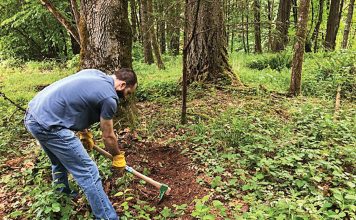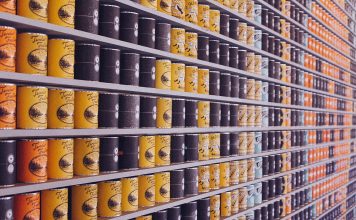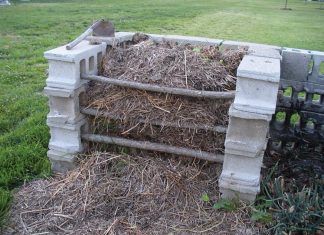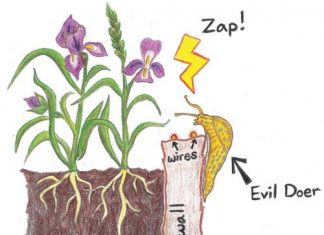 |
|
| Issue #32 Mar/Apr 1998 |
(In the May/June issue [Issue No. 27], we published an article by Dorothy Ainsworth titled “Determined woman builds distinctive vertical log studio,” in which Dorothy detailed how she built a beautiful 1,000-square-foot piano studio. The article and photos were so captivating that many people wrote us to thank us for printing it. Some writers, however, were skeptical. “Could a woman really do that?” the letters said. So I asked Dorothy to write this article not only to answer the doubters, but to give the rest of us a glimpse of the determined woman behind the original article. — Dave)
Dear Dave,
The enclosed answer to the “doubting Thomasinas” had to be a personality and character study, not just a how-to article. The mind behind the motion produces the fuel that drives the machine, and that’s what this article is about.
So many women have come up to me (after reading the piano studio article) and said, “Oh, I couldn’t do that.” I say, “Why not? I’m just a 125 lb. weakling with a little stronger-than-average will and a fair dose of common sense.”
If you choose to print my article, please do so in its entirety, or important psychological ingredients may be left out. Hopefully it will be an inspirational human interest story that may help men and women alike throw off the shackles of convention and forge ahead with their dreams of affordable alternative lifestyles. Your willingness to print an article like this may be just the permission they need.
Thanks for the opportunity to share with others, and teach them by example to say “I can!” instead of “I can’t.”
Sincerely,
Dorothy Ainsworth
I grew up in the middle of a colorful eccentric family—eight of us crowded into a one-bedroom house not far from the ocean. Six beds lined the perimeter of the large living room, early-pioneer style. My parents were lively and creative and philosophical. Although we were poor, they made each of us feel special, and unafraid to be different. Poverty was dignified by laughter, but the work ethic was law.
|
We all had a passion for classical music and science and were constantly busy with projects. The boys built telescopes; the girls took ballet. Dad, a mechanic, built boats as a hobby and painted oil landscapes. Mom was forever hanging clothes on the line and singing opera at the top of her lungs, while our daily beans simmered on the stove. Oranges and tomatoes were abundant and free. It was southern California, 1952.
In the midst of all this “ordered chaos,” I fiercely wanted a room of my own and verbally fantasized about going underground like a mole. My father nonchalantly handed me some tools and went inside. Secretly everyone watched and giggled as the serious red-faced girl flailed movable objects against resistible forces. After one inch in one hour, I accepted defeat and ran off to the beach, where I drew floor plans in the sand with driftwood, and “played house.”
Twenty-eight years later, after two kids and 18 years of single parenthood and waitressing for a living, that driving force resurfaced like a baleen whale coming up for air, and landed on a hilltop in southern Oregon.
|
With a farm loan, I bought 10 unimproved acres that nobody else wanted, on the hot dry side of Ashland, Oregon, and began “Operation Petticoat” from the corset up. Poison oak and rattlesnakes initiated me into the world of property development. I stocked up on calamine lotion and kept my eyes on the ground. To be prepared for a surprise visit by Yul Brynner out of “Westworld,” I bought a gun.
That first summer (1982) I camped out in a big army tent, cooked on a hot plate at the power pole, and showered at the fitness center. After an eight-hour swing shift at the cafe, I’d crawl into my dark cocoon and let the sounds of hooting owls and pulsating crickets lull me to sleep. Gypsy, my faithful blue heeler, stood guard.
Romanticizing in the light of day, I envisioned giraffes traversing the rolling hills and lions crouched down in the wild oats. An old windmill made haunting sounds like a trumpeting elephant. There was stark beauty in the great panorama of bleached blonde hills and blue skies. With a splash of Walt Disney’s watercolor brush, I visualized an oasis in the middle of this safari.
|
Imagination was intoxicating, enthusiasm was exhilarating, but hard work sobered me right up. “Carving out” a place in the country was literally that: pick, shovel, and axe. Delusions of grandeur gave way to gut-busting discomfort. Reality reared its ugly head in the form of a black thumbnail, festering splinters, and bruised shins. Calluses and chapped lips went with the territory. Comfort was a wet rag on the forehead.
Though not pleasant, progress was meaningful and fulfilling. After securing the basics (water, electricity and septic system) I painstakingly acquired carpentry skills by constructing the well’s pumphouse from Sunset’s Basic Carpentry Illustrated manual. Featuring just me and my shadow along with supporting cast, Estwing hammer and Sandvik saw, my building “debut” entertained an attentive audience of one: the dog. It was a huge success according to Gypsy, who wagged her tail and panted in approval whenever I strained and grunted and spewed forth epithets.
With newly found confidence, I graduated to remodeling two out- buildings on the property into usable structures. My son Eric, a pianist and composer, had been evicted from his apartment in town for playing Beethoven at midnight (terrible teenage crime) and we needed a place for his grand piano.
|
Deep in the convolutions of my brain, I had a plan. Always a mother first, I wanted to provide a family homestead—a safe refuge where communal living could be harmonious if times got tough. Being a survivalist, I wanted a future of independence and self-sufficiency. But my greatest desire was to create, through self-expression and perseverance, an aesthetically pleasing atmosphere to foster growth and nurture talent for us all.
At 40, I asked myself, “If not now, when? If not me, who?” Eric and my daughter Cynthia had gone off to pursue performing-art careers on their own, working fulltime. There had never been any child support, no rich relatives, and no government handouts (against my principles), but we had our fair share of a more precious commodity—drive.
My priorities were written in stone. First there would be a music studio, replete with the nine-foot grand piano and an array of electronic equipment for entire orchestral compositions. In today’s high-tech world, a composer needs special tools to be competitive. (In 1795 Mozart could get by with jotting down masterpieces on napkins!) The studio would be an inspiring opportunity for Eric, and my heartfelt contribution to a life force that’s full of ideas, full of hope, and full of purpose. The passion and sincerity of youth shouldn’t wait. (See Backwoods Home Magazine, May/June 1994 issue, for the cover story on building the piano studio.)
|
Economically challenged, I was in a dilemma: how to satisfy my gourmet taste on a fast food budget ($12,000/year). Having a penchant for substantially over-built structures, I wanted at least meat and potatoes! After doggedly researching my options, I had to compromise. Although Ted Benson’s timber frame book was my bible, the U.S.F.S. turned out to be my salvation. I obtained a lodgepole pine permit to cut and carry short logs right out of the forest for a nominal fee. Instead of drooling over smooth oak timbers at $1/inch, I’d sweat over rough logs at 3¢/foot. Rather than using the traditional horizontal method of construction, I’d stand them up vertically. I drew plans for the 1000 square-foot octagonal studio, built a model of it, and got my permit.
During his summer vacation, Eric helped me stockpile 180 logs for $42. The “Waitress Builds Fortress” saga began.
A famous quote became my motto: “He (she) who would do some great thing in this short life must apply himself (herself) to work with such a concentration of his (her) forces as, to idle spectators, who live only to amuse themselves, looks like insanity.”
|
And evidently it did. Boyfriends came and went. Would-be suitors, feigning interest for a possible roll in the star thistle, left permanent skid marks peeling out of the driveway. Well-meaning friends, contemplating the enormity of my undertaking, all droned the same advice: “Why don’t you just move a little trailer up here while you build a stud-frame rectangle and be done with it? You’re doing everything the hard way.” I argued, “There’s more to life than basic shelter. Why not call a hat a roof over your head and be done with it?” They just didn’t get it. To a bird like me, with a strong nesting instinct, a home is a soul investment.
Considering the time element involved in pay-as-you-go construction, the “hard way” was the only feasible way for me. The basic skeleton(s) could be erected now and fleshed out later, as I earned the money. No worries about the weather on logs standing as they grow. On the other hand, studs, unmercifully exposed to the elements, turn into pretzels, nails rust and crawl out, and walls rack. One would have to get a loan for about $40,000 to complete that little box with a roof in one season or end up with a pile of firewood. My land payment alone took 50% of my monthly income.
|
Sometimes when I felt tired and overwhelmed, the demons of self-doubt would creep in. Through tears, I’d vow to avoid negativity, and hang on to my dreams with cat claws! I concluded that the nice thing about living in the country was the people I didn’t meet. When I needed advice, I’d go to the library and check out how-to-do-it books. My only “support system” was my bra straps. Daily jaunts were limited to working at the cafe, rushing my little bag of tips to the bank, doing 100 sit-ups at the fitness center, and a 20 minute jog. An occasional hippity-hop to the hardware shop and lumber yard rounded out my small world of travels.
Tunnel vision was imperative. I stuck to the “plan” and finished the piano studio in three years, for $15,000. Building it was like having a baby—the end result was worth it and I soon forgot the pain. During that three-year working frenzy, I planted an orchard, landscaped with trees, shrubs, and flowers, and built a split-rail fence. Due to lack of attention, my garden was inadvertently “donated” to the deer and insects.
I’m now in the process of building the main house, three years along, with three years to go. It’s also my own vertical-log design (1800 square feet @ $15/square foot), but like a timber frame, it is held together with mortise and tenon joints. My hand-drawn blueprints miraculously passed code without a change or correction. (Jackson County is notorious for its stringent rules and meticulous inspections!)
|
A typical day is not an exciting whirlwind of activity performed by a crew of skilled craftsmen. It’s just methodical me, trudging up the hill every morning, eating oatmeal and skim milk out of a kettle, as I put one foot in front of the other. Arriving at the building site, I focus on the task on hand, mustering up the gumption to get started, then clunk into low gear and begin—measuring, cutting, chiseling, gluing, screwing, sanding, and staining. As the day wears on, I pick up speed like a runaway freight train, and find it difficult to stop until my boyfriend, Kirt, comes home and rescues me (from myself). After years of jogging, energy and endurance are not a problem.
I’ve never claimed to be the consummate craftsperson, but by necessity have become a Jill-of-all-trades. I’m slow and deliberate and always prefer working alone. To avoid distractions and annoyances, I seldom ask for help and only then as a last resort. Given enough time and common sense, I can solve most problems, odd as they frequently are.
Time-consumption seems to be my modus operandi. The roof took all last summer. The plumbing job ate my fall vacation. Window installation has consumed this winter and the chinking will gobble up next summer. Repairs and maintenance are endless. So far I’ve been able to do everything myself but complex electrical wiring and super-human lifting. (I call Kirt.)
I’ve learned that nothing worthwhile is easy to achieve, and you must go for it when you’re hot; procrastination puts out the fire. Steady progress in tiny increments, like a clock in a thunderstorm, insures that the goal which seemed impossible becomes inevitable.
|
Life is tough and complicated for everyone, full of joy and full of grief. Although at times it feels like one is being buffeted around by the winds of circumstance, there is a veritable cafeteria of choices (to not decide is to decide). I monitor what goes into my mind and try to twist reality in a positive direction. I marvel at beauty and seek out intellectual stimulation. I strive to remain unjaded, with a girl’s heart and a woman’s head. I believe humility is a virtue; I’m not ashamed to blush or cry. A smile and a wink from a kindred spirit makes my day.
Ordinary pleasures thrill me: a litter of “army cats” (calico-camouflaged) behind the barn, the cacophony of coyotes at night, a resident frog in the outdoor shower, a tough little roadside weed earning its living in the gravel. Any Bach prelude sends me to heaven; his D-minor concerto puts me to work.
Thoreau said, “Simplify, simplify!” I drive an $800 pickup, eat like a peasant, buy clothes at Goodwill, and never watch TV. Creature comforts are a hot shower, warm bed, and the wood stove a-cracklin’. Designer nails mean “ring-shank” building nails, not bright red talons studded with diamonds. Give me my morning coffee and I’m happy.
|
With my vanity years behind me, I’ll do most anything for a laugh. I measure life in strong heartbeats, daily accomplishments, and peace of mind. Happiness is having my own approval.
Knowing I’ll get all the sleep I need after I die, when my body isn’t moving, my eyes are. I love to read and keep up on the latest in science, medicine, and technology. Photography is my hobby.
I’ve shared the past six years with a remarkably mature and caring man who is half my age, and I’m oblivious to gossip. (He cheerfully volunteered to help me cut and carry the 300 massive logs for the house!)
People frequently question and doubt whether I’ve really developed the property and built the structures myself. Depending on a woman’s cultural persuasion, that could be taken as an insult or a compliment. I like to stick to the facts, and simply hold out my hands to reveal the evidence. These gnarly prehensile monstrosities were a small price to pay for “a room of my own.”
My children? Eric is a classical pianist, composer, piano tuner, and teacher in Ashland. Every year he composes and records an original composition for the Oregon State Ballet, and commercially produces video soundtracks. Cynthia is a successful model, actress, and professional photographer in Los Angeles. I’m a proud mom!
(Dorothy has promised to write a future article on how to build a vertical-log house. She has been documenting her project on video (a la tripod) and it will be made available to our readers upon completion of the house. The classical sound track will be produced by Eric. — Editor)
Learn more about Dorothy and/or contact her at her website www.dorothyainsworth.com
























